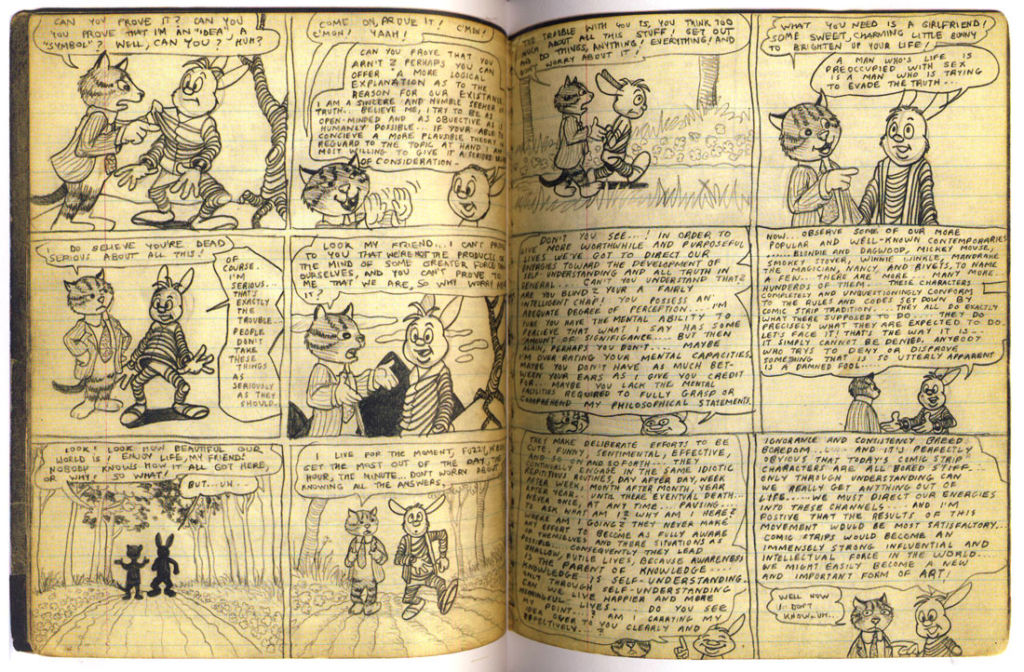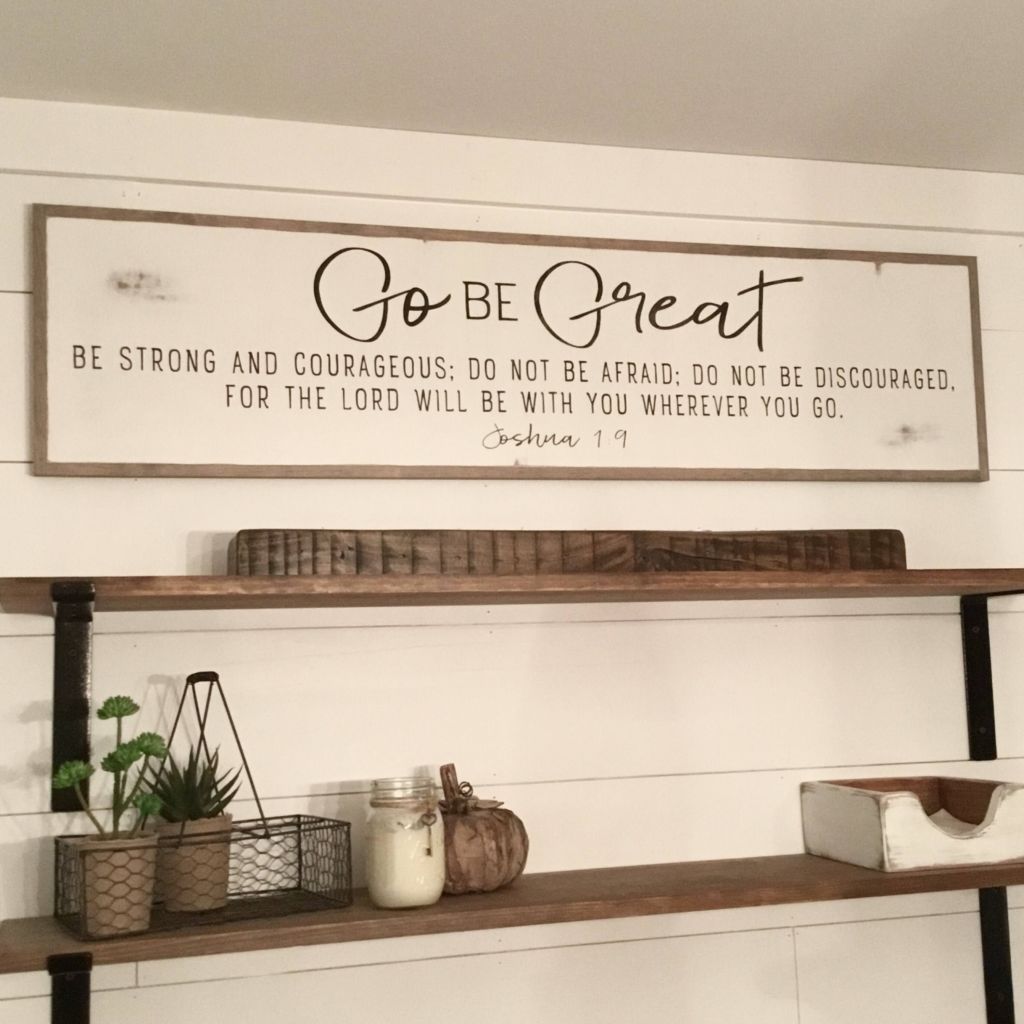When the Words Take Over
Posted By Jef Costello On In North American New Right | Comments DisabledYears ago, I watched a much-acclaimed documentary [2] about the artist R. Crumb. What I remember most about it, however, is not Crumb himself, but his older brother Charles. Like most of the rest of the family, Charles was both an artist and a madman. Indeed, three years after the release of the Crumb documentary, a collection of art by the Crumb brothers was published under the title The Whole Family is Crazy! [3] Charles’ insanity was evident in the comics he drew as a child. These were quite artistically accomplished, but in time the text began to overtake the images. Like most comics, Charles’s (which were never published during his lifetime) included boxes with textual exposition, as well as dialogue and thought balloons. As Charles grew, so did his text — until the comics were entirely made up of exposition and dialogue, leaving no room for images.
Now, maybe I am crazy too, but this has always reminded me of Hegel. It was Hegel’s position that at the end of history, art, as a means of conveying truth, would be superseded by philosophy. In other words, discursive language would become the means by which humanity confronted itself, not myths or images. Words would become the mirror modern man holds up to himself. This certainly seems to have taken place, though not exactly in the way Hegel thought it would. Just walk into the homes of most normies and you will find, plastered all over the walls, the words in which they apparently behold themselves.
“Live, Laugh, Love.” “Friends and family gather here.” “Why walk when you can dance?” “This is us: Our life. Our story. Our home.” “Good friends are like stars: You don’t always see them but you know they’re always there.” “The ornament of a house is the guests who frequent it.” “This is our happy place.” “Blessed.” “Thankful.” “Relax.” Signs for the kitchen are also in plentiful supply (all of them, unfortunately, inducing gags just where one least wishes for them). For example: “‘Made with love’ means I licked the spoon and kept using it.” Or consider my personal favorite, “Homemade with lots of love & butter,” which just makes me think of Last Tango in Paris [6]. If this is the end of history, folks, we are definitely in “not with a bang but a whimper” territory. But you knew that, anyway.
If you have guessed that the vast majority of the people purchasing these items are white women [8], you would be right. You would also be right to assume that they have little or no sense of irony. If I were to hang up one of these things, it would be an expression of postmodern irony, or what the author Paul Fussell [9] called “parody display.” I am also inclined to think that these women have, at most, high school diplomas. But this just dates me. The truth is that these days universities no longer cultivate the tastes of their students, and so for all I know there are doctors and lawyers with “live, laugh, love” crap all over their houses.
A friend of mine has voiced the theory that this trend began with evangelical Christians hanging Biblical quotations in their homes. This seems plausible and, of course, those people fit the profile of white and irony-deficient. What may have occurred is that the Bible verses morphed into the vaguely “spiritual” detritus of “BLESSED,” “THANKFUL,” etc. Then the trend took off from there: “inspirational,” “motivational,” possibly religious, but not necessarily. It’s true that this is a really white thing, but these items are not without black purchasers. The same friend has occasion to enter the homes of black people on a regular basis (primarily to evict them), and he has noticed one item of verbal wall art showing up again and again. Yes, you guessed it: “BLESSED.” As in, “Have a blessed day,” said the black female cashier at PetSmart.
What can explain this strange obsession with using words as decoration — such painfully trite and cringey words? Why are more than 280,000 products bearing the words “live, laugh, love” available from Wayfair? One recent article [12] on this phenomenon attributes it to hard economic times:
In the wake of the 2008 recession, consumers sought inspiration for affordable interior design on image-based inspiration sites like Pinterest and craft-focused e-commerce stores such as Etsy. Prints bearing motivational slogans in cursive type, and wooden cut-out words like “dream”, “family”, “joy” and “blessed” were marketed as an easy way to make a house a home. “Live, Laugh, Love” found its true calling in the form of easy-to-produce and relatively cheap-to-buy word-art decor, attractive for its accessibility in terms of both price and content.
So, hard times have driven people to hang cringey slogans on their walls because they are (a) cheap and (b) “motivational”? Sorry, but I don’t find this convincing. What about attributing this trend to bad taste, pure and simple? “Tacky,” my mother would have said, if she had lived to see this “word-art decor.” None of the articles I have seen that treat this phenomenon — and there are a few — attributed it to a decline in taste. Presumably this is because making any qualitative distinctions between people now calls to mind the sound of jackboots.
However, bad taste is also not a sufficient explanation, for it cannot explain why so many people are now drawn to words rather than images. In the past, people with bad taste filled their homes with bad paintings, like the ones of dogs playing poker, or anything by Thomas Kinkade [13]. Saying that people want something cheap, cheery, and “motivational” also won’t cut it, for similar reasons. Why didn’t people start buying cheap, cheery, motivational pictures? Why not a picture of people actually living, laughing, and loving?
Possibly because this would require interpretation. In case you have not noticed it, most people today are allergic to subtlety. Everything has to be obvious and explicit. When I was teaching school, I noticed that any text whose meaning did not instantly unbosom itself when first glanced upon would cause my students to quickly give up in frustration. Nothing can be left to be inferred; nothing left to the imagination. If you don’t believe me, you haven’t been to the movies lately. The same is true even of food. Overseasoned, oversweetened, overcooked, overladen with layers of things that do not belong together — on the principle that since each of these things pleases individually, it would be infinitely better to have them all, together, and now, now, now. Thus, was born the “breakfast pizza” and the three- to four-layer cake of multiple icings, so sickeningly sweet it burns on the way down.
The great advantage of owning a “live, laugh, love” sign rather than a painting of people living, laughing, and loving is that it requires no cogitation at all in order to get the point. There are no depths to be plumbed. Unless the owner has a relative who teaches philosophy someplace, no one is going to ask, “But what is it to live? What is a good life? Mustn’t it involve something more than laughing and loving?” This isn’t the sort of response Karen is after when she hangs up her “live, laugh, love” sign over the fake fireplace. But I do think that she is hanging it to generate some kind of response from others, and that this is an important element in the entire phenomenon.
As with so much else today, the key to understanding the folly lies in seeing what sort of impression people are trying to make by means of it. Karen’s carefully curated Instagram page gives viewers the impression that she is always smiling, baking cookies, petting golden retrievers, enjoying sunsets, having delicious, non-fattening, and highly photogenic desserts, raising children who never create any trouble, and celebrating diversity. All else has been carefully omitted: her drinking problem, her husband’s opioid addiction, her multiple prescriptions for psychiatric drugs, the scars on her arms from self-harm, and her maxed-out credit cards.
But how can she control the impressions people have of her when they walk into her home and see her up close? Answer: hang up signs that signal that Karen, some appearances to the contrary, is one of the good ones. She knows what’s important in life — that it’s all about living, laughing, and loving. This is, of course, a woman’s view of life (and a shallow woman’s at that), but it’s the opinions of other women about which she naturally cares the most. Her kitchen signs announce that her cooking is full of love — and butter. We feel a bit inadequate in this kitchen (“Is my cooking filled with love?”). We feel this way in the den also, where a pillow orders us to “RELAX.” Apparently, Karen is just one of those people who knows how to relax — gee, I wish that were me. We do not realize that Karen’s secret to relaxation is benzodiazepine (how about a pillow that says “BENZO”?).
 [14]
[14]You can buy Jef Costello’s Heidegger in Chicago here [15]
Karen flatters you with her sign that says her guests are the ornament of her home. Yet even this sign is calculated to make visitors feel inadequate. After all, they probably don’t feel that way about their guests. Most guests are relatives and, realistically, most relatives are disagreeable moochers we house out of obligation and are glad to be rid of. However, we find it hard to resent Karen for being so “grounded,” so generous, so buttery, and so relaxed, for another sign tells us she considers herself “BLESSED.” This is supposed to mean “I don’t claim any credit for what I have, nor do I take it for granted. I know that it is a gift. I am humble.” Actually, what it means is “look how humble I am.” Virtue is negated when it fills the blank in “look how ______ I am.”
The most obvious and graceless signaling has been relegated to the yard. There we will find a sign that informs us that the people in Karen’s house believe in “science,” and they believe that “black lives matter,” etc. These liberal yard signs are too familiar to my readers to require careful description. There has never been a purer example of signaling. These signs are obviously not intended to persuade or to change minds; they are intended solely to advertise the “virtue” of the smug, wine-drinking shits that own the property. Inevitably, “conservative” yard signs, in designs similar to their liberal equivalents, have popped up, with multi-colored lines of text announcing, “Biden stole the election,” “Fauci can’t be trusted,” “Hillary belongs in prison,” etc. These signs are dumb, but a different kind of dumb. They are intended more to piss off passing Democrats than to signal Trump-voter virtue.
We even have yard signs now for that peculiar breed of pretentious, pseudo-intellectual crank who thinks he’s far superior to either group: the so-called “independent voter.” One such sign reads, “In this house we believe that simplistic platitudes, trite tautologies, and semantically-overloaded aphorisms are poor substitutes for respectful and rational discussions about complex issues.” The owner who thrusts this sign into his grass takes great delight in the fact that most passersby will not know what a tautology is, let alone a “semantically-overloaded aphorism.” Trouble is, he doesn’t know either.
Am I being uncharitable? Could it be that the indoor signs at least, the ones of the “live, laugh, love” variety, are pitiable attempts by unhappy, unfulfilled people to remind themselves of the brighter side of life? This is the question raised by another recent article [17]:
Are these positive affirmations evidence that we are all just searching for a glimmer of hope amid the desolate wasteland of modern life, modern politics and the aching chasm of human waste that is social media? Is it, perhaps, an attempt to be good when things are so, so bad?
I don’t think it needs to be either-or: either this phenomenon is motivated by despair, by a thirst to be reminded of what ought to matter in life, or it is an expression of narcissistic virtue-signaling. Both motivations can co-exist in the same person, and often do, or one can be present without the other. That these signs function as “reminders” of some sort is supported by one subgroup of “word-art” that I have not so far mentioned. These are the signs that seem just to function as labels: a sign that says “PORCH” in big letters hung on the porch; “KITCHEN” in the kitchen; “VERANDA” on the veranda; “LAKE HOUSE” in the lake house, etc. A few extra words are sometimes permitted, as in “We love our BEACH HOUSE.”
Are these signs intended for the addlepated, who might forget they are on the porch if it weren’t for the sign that says “PORCH”? Should someone get Joe a big sign for the Oval Office that says “OVAL OFFICE”? A more plausible, but still-too-simple explanation is that this is, once more, merely bad taste — the bad taste of people who needed to fill a space on the porch and couldn’t come up with anything better. However, I think it is possible to see this “label” trend as an expression of modern despair as well. A fashionable trend in “spirituality” today speaks of something called “presence” or “mindfulness.” This is what figures like Eckhart Tolle [19] have made millions preaching the gospel of. The idea is that modern people fail to “be present” to others, to their body, to place, and to the moment.
 [20]
[20]You can buy Jef Costello’s The Importance of James Bond here [21]
What causes this “absence”? The traditional explanation one would get from a Buddhist is that their minds are full of thoughts, especially cares. The “monkey mind” has taken over and now they can no longer enjoy the smile on a child’s face or the feeling of rain on their cheeks because they are “elsewhere,” thinking of a thousand other things. But it seems to do far too much credit to modern people of the most recent vintage to suppose that their minds are too active. What is more likely is that the real is no longer real to them. The place itself — the porch, the veranda, the beach house, etc. — is no longer, for modern people, an immediate reality. Instead, the “virtual” has overtaken the real, like the words overtaking the images in Charles Crumb’s comic. What is valued now is not the real, but how the real is “presented.”
It’s like those tourists you see on your vacations who are so preoccupied with photographing the sites that they seem not even to be seeing them. No matter: we’ll enjoy the sites later when we’ve posted the pictures on Instagram. But then, of course, the moment is gone — as it is always gone for modern people, who live perpetually for some vague idea of “real living” (and, presumably, laughing and loving) that will take place in some indefinite future. Fulfillment is not had through experience, but through the anticipation of experience, or through the visual record of experiences we were never really “there” for. Can we blame people, then, for wanting to remind themselves that they are on the “PORCH”? Or on the “VERANDA”? Or that they are blessed enough to own a “BEACH HOUSE”? This is modern consumerist America’s version of “Be Here Now [22].”
I know I should pity the white people who put up these signs. And I know I come across as a thorough misanthrope. I know I should feel sorry for people with such bad taste, whose lives are so empty they need to be “motivated” by vacuous slogans staring back at them from the wall. I know I should feel sympathy for anyone whose internal life is so impoverished they feel gladdened by the impression a “BLESSED” sign makes on the neighbors. But I feel so alienated from people today I’m at the point where it is difficult to imagine they have any kind of internal life at all. It is difficult, consequently, not to see these humans merely as humanoid; merely as ciphers or empty vessels with human form.
And all possibility of my feeling any such sympathy evaporated as soon as I ran across the best-selling “lived, laughed, loved” coffin [23].
* * *
Counter-Currents has extended special privileges to those who donate $120 or more per year.
- First, donor comments will appear immediately instead of waiting in a moderation queue. (People who abuse this privilege will lose it.)
- Second, donors will have immediate access to all Counter-Currents posts. Non-donors will find that one post a day, five posts a week will be behind a “Paywall” and will be available to the general public after 30 days.
- Third, Paywall members have the ability to edit their comments.
- Fourth, Paywall members can “commission” a yearly article from Counter-Currents. Just send a question that you’d like to have discussed to [email protected] [25]. (Obviously, the topics must be suitable to Counter-Currents and its broader project, as well as the interests and expertise of our writers.)
- Fifth, Paywall members will have access to the Counter-Currents Telegram group.
To get full access to all content behind the paywall, sign up here:
Paywall Gift Subscriptions
 [26]If you are already behind the paywall and want to share the benefits, Counter-Currents also offers paywall gift subscriptions. We need just five things from you:
[26]If you are already behind the paywall and want to share the benefits, Counter-Currents also offers paywall gift subscriptions. We need just five things from you:
- your payment
- the recipient’s name
- the recipient’s email address
- your name
- your email address
To register, just fill out this form and we will walk you through the payment and registration process. There are a number of different payment options.








